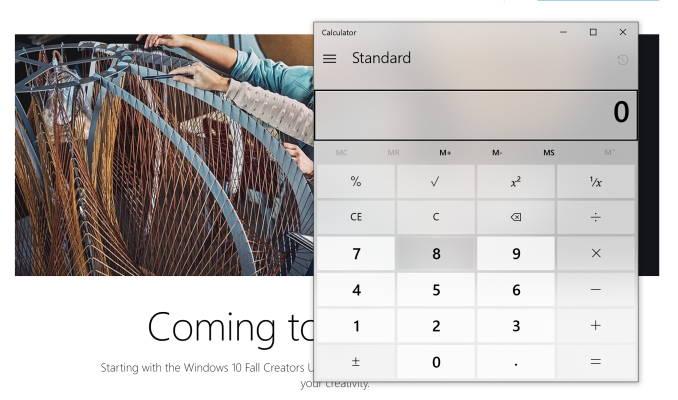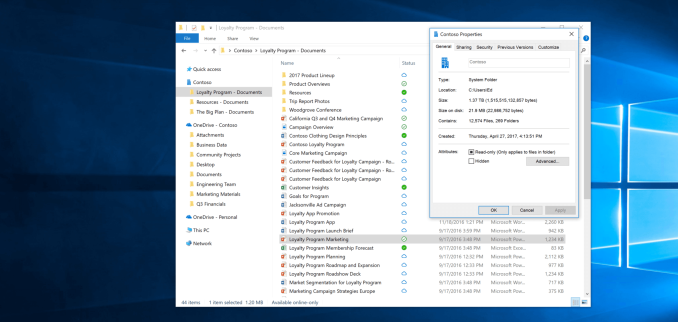Windows 10 Fall Creators Update Coming October 17
This morning at IFA in Berlin, Terry Myerson, EVP of the Windows and Devices Group at Microsoft, announced that the next Windows 10 update will be launched worldwide on October 17. Dubbed the Fall Creators Update, it’s the first such update since the Creators Update debuted in the spring, and with this update, Microsoft will officially begin their bi-annual update cadence. The Fall Creators Update was first announced at Microsoft’s developer conference, Build. It, like the other updates to Windows 10 preceding it, continues the evolution of Windows 10, bringing some new features to the table, and updating the underlying platform with new capabilities.
This will be the fourth major update to Windows 10 since it launched in July of 2015, and with the benefit of time, it’s easy to forget the dramatic changes it brought, merging the touch-first design of Windows 8, with the desktop happy Windows 7, into a very capable, and flexible platform. Windows 10 brought some major changes, and most notably was the move to a continuous servicing model, which is the underlying basis for these bi-annual updates. The original servicing model was a lot more fluid, and with the traction of Windows in the enterprise market, Microsoft needed to offer a model that could be planned for, which they now have. You could easily argue that this model of twice a year updates to Windows 10 is too fast for the enterprise, and I would not disagree, but having a plan is better than the random updates seen prior to this.
There’s quite a bit coming to the Fall Creators Update, despite the name being only one word different than the Creators Update it is superseding. Not all of the features announced at Build have ended up making it in, which is likely the trade-off of moving to a rigid release schedule, but the majority are. It’s also interesting to note that Microsoft has, for some time, been able to update portions of Windows 10 without these larger feature updates, but has more or less chosen the stance of not doing that, perhaps in an effort to beef up the content of each update, but one of the main features announced at Build has already started to creep into the current version of Windows, and that is the Fluent Design.
For a full recap of Fluent Design, check out our coverage from Build, but it’s a new design language for Windows 10 which takes us further away from the extreme flat look of Windows 8, and brings about effects with lighting and transparency which both look great, and add functionality. Lighting and movement are going to be key elements now, bringing contrast and context to buttons and more. Some apps have already been updated with Fluent Design, such as the calculator on the current version of Windows, and the contemporary design looks great.
Windows Ink is getting some more love, as it tends to with each update. Microsoft loves the digital pen, and that plays out in both their software and hardware developments. Windows 10 is finally going to let you ink right onto PDFs in the Fall Creators Update, which should please many. There’s now a Find my Pen feature built into Windows, and while pens don’t have GPS built-in for perfect tracking, Windows will be able to tell you where it last was connected to your pen, which should help those of us who can’t seem to keep track of them. Inking is also gaining more AI capabilities to automatically make items into what you’re attempting to create, such as turning boxes into a table.
Photos is getting new features added to let you remix your photos, videos, music, and more, into stories. Luckily, Photos is still going to be called Photos though, so you should still be able to find your pictures even though there will be additional capabilities added to the app.
The one feature I am looking forward to more than any other is easily OneDrive Files On-Demand. Finally, we’ll be able to see our entire OneDrive in Windows Explorer without having to download it first, and because modern PCs have limited storage thanks to solid state drives, the on-demand files don’t take up any space on your system unless you need them. This feature originally existed in Windows 8.1, but underlying issues with the solution at that time could lead to apps throwing errors, because they weren’t aware of this feature. With it now being built into the file system of Windows, that should hopefully be avoided. The only issue people will run into is if they forget to download the file they need before going offline, and we’ll see if the file graphics added will be enough to make it obvious.
Another feature coming is the ability to automatically delete files from your Download folder over time. As someone who tends to download and forget, this could be very helpful in keeping my drive clean.
Eye control is also coming to Windows 10, which should be a great help making Windows 10 more accessible to those that can’t operate a mouse, or use touch. The ability to control the mouse with your eyes is the next step on Microsoft’s path to making Windows 10 more accessible to all.
Windows Mixed Reality is also coming as part of the update, and several OEMs such as Acer, Dell, HP, and Lenovo, will all have mixed reality headsets available when the Fall Creators Update ships. The push for VR seemed to be a very strong want from everyone, until it arrived and very few bought in, but we’ll see how these lower priced mixed reality headsets do before passing judgement.
There’s plenty of other features coming as well, such as improved HDR and wide color gamut support, advances in the Windows Subsystem for Linux, and security enhancements as well. The Windows Store is going to be adding more desktop apps using the Desktop App Converter, formerly known as Project Centennial. iTunes, as an example, is supposed to be coming to the Windows Store via this desktop bridge, and many other big-name apps as well. Microsoft never got the buy-in they wanted or needed with UWP, but this is a good step to at least get the apps everyone knows and needs available on the store, and then they can go from there. This is especially important thanks to Windows 10 S, which only allows app installs via the store.
There’s more to come later as well. Almost a year ago, Microsoft and Qualcomm came together to announce new PCs running on Qualcomm CPUs, meaning Windows 10 is going to be available on ARM, with x86 emulation. Intel isn’t too happy about this though, as they mentioned in an earnings call, but we should be seeing some of these devices soon, since they are supposed to be available in the second half of 2017.
We’ll look into some of these Windows 10 features with a more in-depth look when they features are available to all, so stay tuned.
Source: Microsoft





